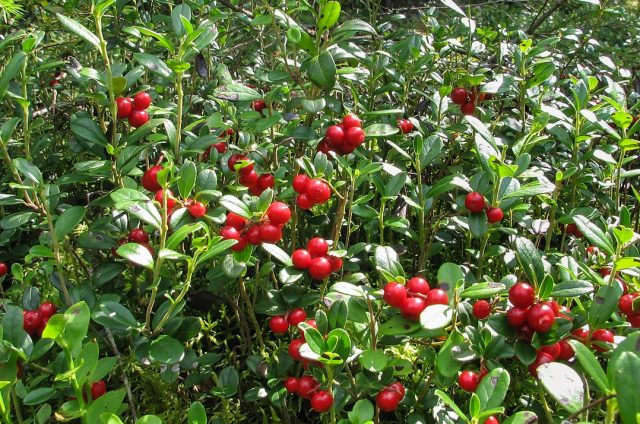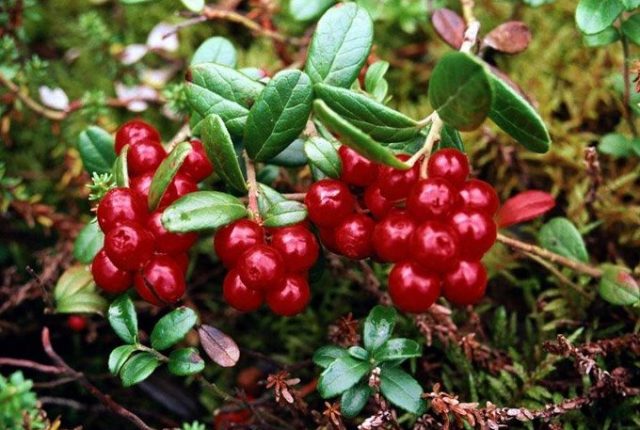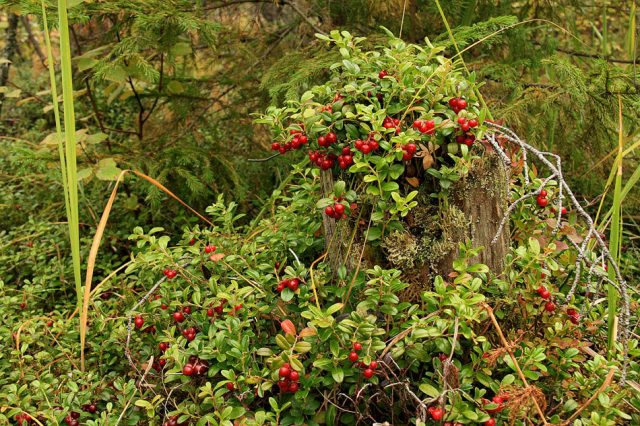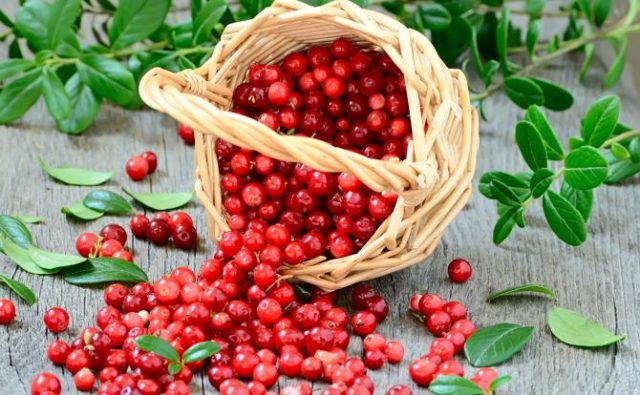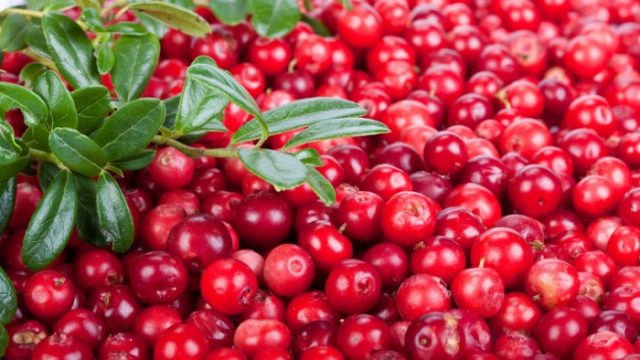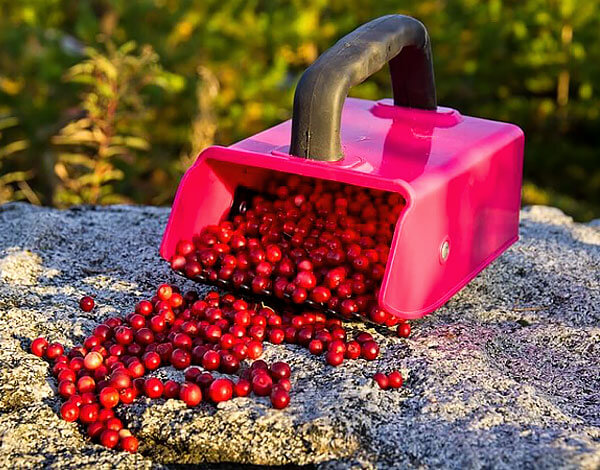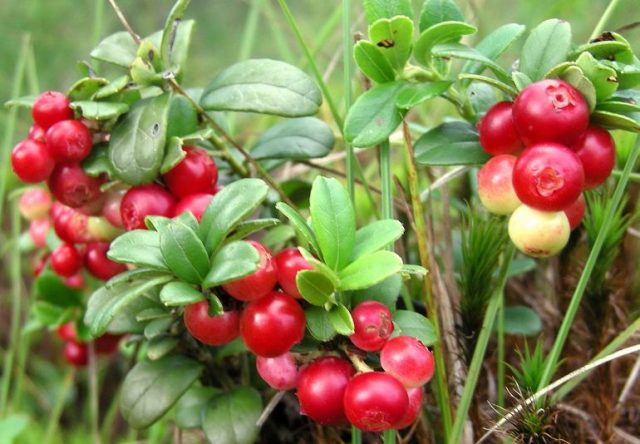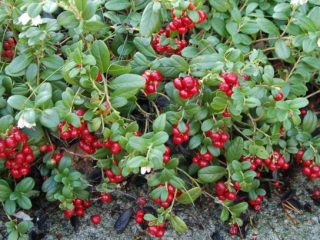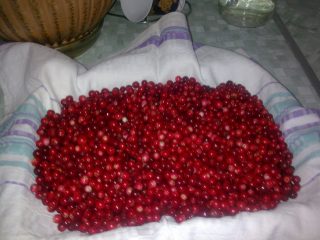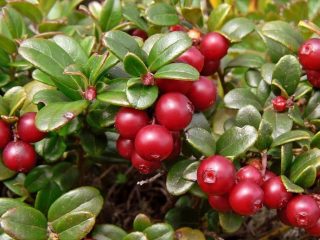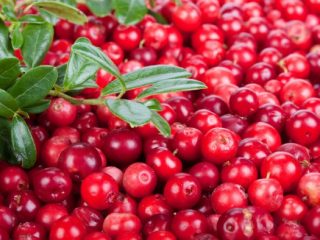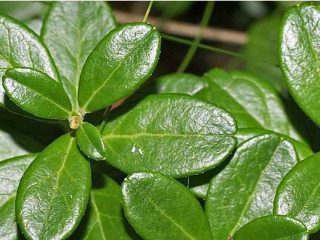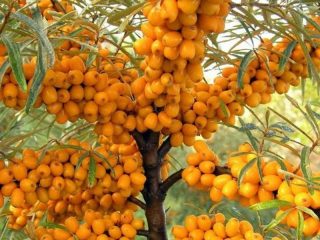Content
Common lingonberry is a forest or marsh berry with sweet and sour vitamin berries. It grows in swamps and forests where it can be picked from bushes and brought home. And also it is grown on industrial sites for fresh consumption or for further processing.
Lingonberry: plant description
Lingonberry (Latin name of the species Vaccínium vítis-idaéa) belongs to the Heather family. According to her detailed description, it is easy to imagine how she should look and find her in nature:
- This is a shrub with non-falling, always green leaves. They are leathery, alternate, frequent. Their upper surface is dark green, glossy, the lower one is matte and light green. The shape of lingonberry leaves is obovate or elliptical, their edges are slightly bent down. The leaf blades are small, from 0.5 to 3 cm long, up to 1.5 cm wide, sit on short petioles.
- The rhizome of this plant is creeping, horizontally located, a fungus lives on its surface, which absorbs minerals from the soil and transfers them to the plant.
- Underground shoots with dormant buds extend from the rhizome.
- Aboveground shoots are branched, ascending, short, only 10–20 cm tall. However, if the shoots of lingonberry are forced to overcome any obstacle that has arisen in their path, then they can stretch much longer - up to 1 m.
- Her flowers are white or pale pink, bell-shaped, regular, bisexual, with an unexpressed smell, sit on short stalks. They are collected in drooping brushes of 10–20 pcs. together.
- After flowering, which takes about 2 weeks, round, shiny berries appear in their place.
What the common lingonberry plant looks like is shown in the photo.
Description of lingonberry berries
They are small (up to 8 mm), red, with a dried calyx at the top. The taste of lingonberry berries is characteristic - sweet and sour, with bitterness. They ripen in late summer - early autumn, but after the onset of frost they soften and become watery. They still remain on the stalks and can even sag like this all winter, but in the spring they fall off from any touch. In winter, birds feed on them and carry seeds around, spreading the plant further and further.
What are lingonberries
Lingonberry is a typical marsh and forest berry. It grows in nature completely freely, occupying areas of various sizes, from small meadows to large thickets. But also cultivated forms of this berry have been bred, which are grown on an industrial scale. There is also garden lingonberry, intended for planting and growing in garden beds in private household plots. Cultivated varieties are maximally adapted to growing conditions in home beds, they have higher yields than wild forms. The yield of berries with full coverage of the plantation is 3 centners per hectare or more.
How lingonberry grows
Lingonberries in nature, as a rule, grow in clumps. They consist only of lingonberries or it is interspersed with mosses, other berries - blueberries, blueberries, etc., grass.In such thickets, it is not easy to distinguish any one plant, the roots and shoots of many specimens intertwine and form a continuous carpet. Although the lifespan of each individual wild plant of lingonberry is relatively short - only 10-15 years, the entire plantation, which is formed by growing many specimens, can live for more than a hundred years.
The lingonberry bush grows like this: the seeds germinate and from them by the end of the first season a 1–2 cm shoot with a wintering bud is formed. The next spring, the main shoot grows out of it, which dies off after 3 or 4 seasons, and lateral shoots grow in its place. Then shoots of the second order appear, and then they come to the surface and underground shoots. They form new bushes. How lingonberry grows in the forest can be seen in the photo.
When the lingonberry ripens
Lingonberry ripens almost throughout its growing area in August or September. It is at this time that you can go to the forest to collect it. The harvesting season can be extended until frost, that is, in some regions until November. After the autumn cold snap, the berries lose their bitterness, but they become soft and, when placed in a basket, immediately let the juice flow and flow. Therefore, berries harvested in November are only suitable for quick processing into juice or for homemade preparations - making jam, jam, as well as fresh canning with sugar.
When you can harvest lingonberries in Russia depends on the region. In the northern regions, this can be done from the second half of September. In Siberia, the Central region, the Moscow region and the Urals, it ripens a little earlier - you can go for berries starting from the first days of September.
The ripening time is influenced by the location of the site with lingonberries - on open plots, it ripens earlier than on those located near forest thickets. And it is also influenced by the weather in the current season - if the summer is hot, then the berries will ripen earlier than in a cool and rainy one.
Timing of collecting lingonberries in 2019
In each region, the start of the harvest of lingonberry fruits occurs at different times, but, in general, there is no significant interval between the beginning of the collection of lingonberry berries in the Russian regions. The end dates are also different. Usually, you can pick berries in the southern regions a few days earlier than those located to the north. Check the local news for lingonberry picking dates in 2019.
To go for lingonberries in the swamps or in the forest, you must first obtain permission from the local authorities. You can get the appropriate permission from the environmental department. Without it, fines may be imposed on citizens, both individuals and entrepreneurs. The same goes for those who purchase harvested products.
Where does lingonberry grow in Russia
It can be found in forests, both overgrown with coniferous trees, and in mixed ones, in peat bogs, especially in dry ones, in shrub thickets, sometimes in plain and mountain tundra, alpine forests.
In Russia, this berry plant is found in the Caucasus, Altai, Urals, Karelia and northern regions, Western Siberia, and the Far East. It can be found in Ukraine in the Carpathians and in Belarus in Polesie. In general, the habitat of lingonberry as a species covers North America, the countries of Central and Northern Europe, as well as Asia.
Where to collect lingonberries in the Leningrad region
There is a berry practically throughout the region: in the Vyborg district, in the Luga district, near Priozersk. There are lingonberry places in the Leningrad Region near the villages of Slantsy, Sverdlovo, Vyritsy, in the forests near Zelenogorsk. You can get there by commuter train.
Where does lingonberry grow in the Moscow region
In this area, the berry grows mainly in sandy areas near rivers and near swamps.In the Moscow region, it is collected mainly in the coniferous forests of the Meshcherskaya lowland, namely in the Shatursky and Yegoryevsky regions.
Lingonberry pickers
Gathering small lingonberry berries with your hands is a long and tedious business. In order to quickly collect them and not damage them, you can use a special device - a handheld harvester. For the same purpose, use scoops and rakes.
What is the best way to pick lingonberries: with a combine or by hand
Definitely, picking by hand for the lingonberry itself is the most gentle. If you pick the berries one at a time, then the bush gets minimal damage: the leaves and twigs remain intact, the root system of the plants does not suffer. When harvested with a combine, the plant is injured in one way or another, but if you use it correctly, the harm will be insignificant. Of the shortcomings, it can be noted that in this case, in addition to berries, blades of grass, leaves, twigs of other plants get into the harvester, and after collecting they have to be sorted out. This does not happen with the manual collection option.
However, the harvester significantly speeds up this process, so everyone has to make a choice for himself how best to collect lingonberries - manually or using various devices.
Lingonberry harvester
How do I get this device? It is available for purchase as various variations of this fixture are available at retail. Combines are manufactured by different companies and therefore have slight differences in size, shape and design. They are made of steel, wood or plastic. These are simple devices that include a body, a handle and a comb, with which the berries are pryed off and removed from the twigs. After which they end up in a volumetric receiver (body), from where, when it is full, they are poured into a basket. To prevent the berries from spilling out back, the lingonberry harvester has a partition that can be adjusted if necessary.
A harvester for collecting lingonberries can be made with your own hands, since there is nothing complicated in its design and manufacture. The main thing to remember when manufacturing is that there is a distance of at least 5–6 mm between its teeth, so that the berries can pass between them, and also that they should be rounded, not pointed and not too thin, so as not to spring. The length of these teeth is about 10–20 cm, enough to grab the entire lingonberry bush with just one smooth movement and break it off.
You can make a harvester according to simple drawings that are available on the Internet. The material of manufacture can be any, it can be wood or thin metal, for example, sheet steel. And you will also need screws or self-tapping screws to connect individual parts and tools that will need to cut them according to the patterns. The harvester can also be used to collect other forest berries - cranberries, blueberries, blueberries and cloudberries.
How to quickly collect lingonberries with a combine
Using the lingonberry harvester is extremely simple - just pry the berries with it like a scoop and pull it up. In this case, twigs with leaves freely, without tearing off, pass through the teeth, and the berries remain and roll into the "scoop".
You need to act smoothly, and not in jerks. When the capacity of the device is full, pour the crop into a basket or bucket. It takes relatively little time to fill the entire harvester, since a lot more would have to be spent with manual harvesting. You need to try not to step on the bushes and move as carefully as possible. This will keep the lingonberry bushes intact and intact. Next year, many tasty and healthy berries can be harvested at this place again.
How to correctly collect lingonberries with a combine is shown in the video.
Lingonberry rake
This device is similar to the usual familiar rake. They also have teeth, but they are rounded, spaced 5 mm apart. Behind them is a wide container, into which plucked berries fall.The rake has a rather high handle, so it is convenient to use them. Due to the fact that the rake has a wider receiving container, with their help you can collect more berries at a time than with a combine.
How to quickly pick lingonberries
If you don't have a harvester or a rake, you can make the simplest such device out of a plastic bottle and a wooden handle. To do this, you need a plastic bottle of mineral water, for example, or juices. But it is better to choose bottles made of durable rather than soft plastic - they will last longer. You need a bottle with a wide neck so that a wooden handle can go into it. And you will also need a sharp knife, which will need to cut a hole in the bottle and a rope or cord to tie the handle to the bottle.
How to make such a small home-made "harvester"? Everything is very simple. You must first cut a round or square hole on one side of the bottle and give it the shape of teeth from one edge. The plastic is quite tough, so such teeth will be able to tear the berries from the branches without any problems, they will not bend. Collecting lingonberries using such a device is carried out in the same way as with industrial combines.
Does lingonberry ripen after harvest
It is believed that this berry, even harvested not quite ripe, can ripen. Therefore, if you come to the forest, and the lingonberry bushes are strewn with unripe berries, then you should not go back. You can collect, bring home and lay it out in a warm place.
How to ripen lingonberries at home
To stimulate ripening, you can use this method: put vegetables or fruits, for example, ripe autumn apples, next to the lingonberries. They release ethylene, a gas that causes the berry to turn red. Those who have tried this method claim that the lingonberries ripened in this way are no different from those ripened on the bushes.
Conclusion
Common lingonberry is a wild berry with a wonderful taste and very healthy. It is very easy to collect it in nature or grow on the site. When it comes time to collect, you can use various devices that simplify the work - combines, shovels, rakes. Or just pick the berries with your hands.
